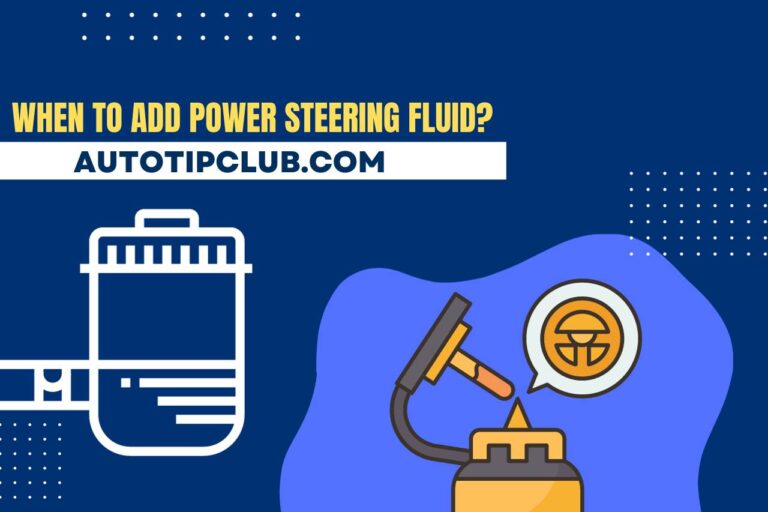What is Power Steering Fluid Made Of?
Knowing the ingredients and composition of the power steering fluid is beneficial in more ways than one. Understanding the composition of power steering fluid can help someone choose the right type of fluid for their vehicle and ensure the proper maintenance of their power steering system.
If this is a topic that interests you, this article will be a helpful one. Let’s get going!
What is Power Steering Fluid Made Of?
Power steering fluid is primarily made of mineral or synthetic oil, blended with specific additives tailored to the steering system’s demands.
The following things are included when making power steering fluid.
Base Oil
The cornerstone of the fluid. While mineral-based oils were traditionally used, modern power steering systems often prefer synthetic oils. Synthetics offer enhanced temperature resistance, ensuring fluidity in extreme conditions.
Additives
These are not mere fillers but serve crucial roles in preventing corrosion and so on.
- Lubrication Boosters: They reduce friction, preserving the power steering components and prolonging their lifespan.
- Corrosion Inhibitors: These protect the system’s metal components from rust and degradation.
- Viscosity Stabilizers: Vital for maintaining the fluid’s consistency across temperature variations.
- Anti-foaming Agents: A critical inclusion to prevent air bubbles, ensuring the fluid transmits pressure uniformly.
- Detergents and Dispersants: These ensure the steering system remains uncontaminated, averting deposits of sludge and other residues.
We will explain all about these in a minute.
What Are Lubrication Boosters in Power Steering Fluid and How Do They Work?
Lubrication boosters in power steering fluid are additives that enhance the lubricating properties of the fluid. These additives typically consist of compounds such as friction modifiers and anti-wear agents.
Friction modifiers help reduce friction between moving parts in the power steering system, such as the pump, gears, and bearings. This helps improve the efficiency of the system and reduces wear on these components.
Overall, lubrication boosters in power steering fluid work by reducing friction and wear between moving parts, which helps improve the efficiency and longevity of the power steering system.
What Are Corrosion Inhibitors in the Power Steering Fluid?
Corrosion inhibitors typically contain chemicals such as organic acids, amines, or phosphates, which react with the metal surface to form a thin film that acts as a barrier against corrosion. This film is able to withstand the harsh conditions within the power steering system, including heat, pressure, and mechanical stress.
As mentioned there are several types of corrosion inhibitors used in power steering fluids. Some common ones include:
- Ethanolamines: Such as monoethanolamine (MEA), diethanolamine (DEA), and triethanolamine (TEA).
- Phosphates: Such as zinc dialkyl dithiophosphate (ZDDP).
- Amines: Such as octadecylamine (ODA).
- Organic acids: Such as benzoic acid, citric acid, and tartaric acid.
What Are Viscosity Stabilizers and What Do They Do?
Viscosity stabilizers are additives used in power steering fluid to help maintain the fluid’s viscosity over a wide range of temperatures. Viscosity refers to the fluid’s resistance to flow, and it is important to ensure that the power steering system operates smoothly and efficiently.
Some common viscosity stabilizers used in power steering fluid include:
- Polyisobutylene (PIB): PIB is a synthetic polymer that is commonly used as a viscosity stabilizer in power steering fluid. It helps prevent the fluid from thinning out at high temperatures.
- Olefin copolymers: These polymers are derived from olefin monomers and are used to stabilize the viscosity of the power steering fluid.
- Polyalphaolefins (PAO): PAOs are synthetic hydrocarbon polymers that are used in power steering fluid to help maintain viscosity stability.
- Diene polymers: Diene polymers, such as polybutadiene and polyisoprene, are used as viscosity stabilizers in power steering fluid.
Viscosity stabilizers work by adjusting the fluid’s viscosity index, which is a measure of how much the viscosity of the fluid changes with temperature. In general, viscosity stabilizers help prevent the fluid from becoming too thin at high temperatures or too thick at low temperatures, which can affect the performance of the power steering system.
By stabilizing the viscosity, these additives ensure that the power steering fluid provides consistent hydraulic pressure and lubrication to the system components, regardless of the operating temperature. This helps maintain smooth steering operation and prolongs the life of the power steering system.
What are Anti-foaming Agents in Power Steering Fluid and How Do They Work?
Anti-foaming agents in power steering fluid are additives that help prevent the formation of foam in the fluid. Foam can reduce the effectiveness of the power steering system by causing sponginess in the steering feel and reducing the lubricating properties of the fluid.
Some common anti-foaming agents used in power steering fluid include:
- Dimethylpolysiloxane: This is a silicone-based compound that is widely used as an anti-foaming agent in power steering fluid. It works by breaking up surface bubbles and preventing them from coalescing into foam.
- Polyethylene glycol: This compound is sometimes used as an anti-foaming agent in power steering fluid. It works by reducing the surface tension of the fluid, which helps to prevent foam formation.
- Polysorbate: Polysorbate is a surfactant that is sometimes used as an anti-foaming agent in power steering fluid. It works by lowering the surface tension of the fluid, which helps to break up and dissipate any foam that may form.
Anti-foaming agents work by reducing the surface tension of the fluid, which helps to break up and dissipate any foam that may form. They do this by either preventing air bubbles from forming in the fluid or by causing existing air bubbles to collapse more quickly.
By preventing foam formation, anti-foaming agents help maintain the proper hydraulic pressure in the power steering system and ensure that the fluid can effectively lubricate and protect the system components. This helps to prolong the life of the power steering system and ensure smooth and reliable steering operation.
What are Detergents and Dispersants in Power Steering Fluid and How Do They Work?
Detergents and dispersants are additives in power steering fluid that help keep the system clean and prevent the buildup of sludge and deposits. They work in slightly different ways:
Detergents
Detergents in power steering fluid work to clean and remove existing deposits and sludge from the system. They do this by breaking down and suspending these contaminants in the fluid, allowing them to be carried away and filtered out of the system.
Dispersants
Dispersants, on the other hand, work to prevent the formation of deposits and sludge by keeping particles in suspension in the fluid. This prevents them from settling out and forming deposits that can clog the system.
Together, detergents and dispersants help keep the power steering system clean and free from harmful deposits, ensuring smooth and reliable operation.
Related



My name is Robot McCullum, and I’m an Automotive Engineer with 20+ years of experience in the automotive field. I’ll give you step-by-step instructions for recognizing and fixing complicated technical problems in an uncomplicated manner. www.AutoTipClub.com, is your best resource for in-depth tutorials, insightful tips, and practical advice designed and developed either for seasoned vehicle collectors or daily drivers.







